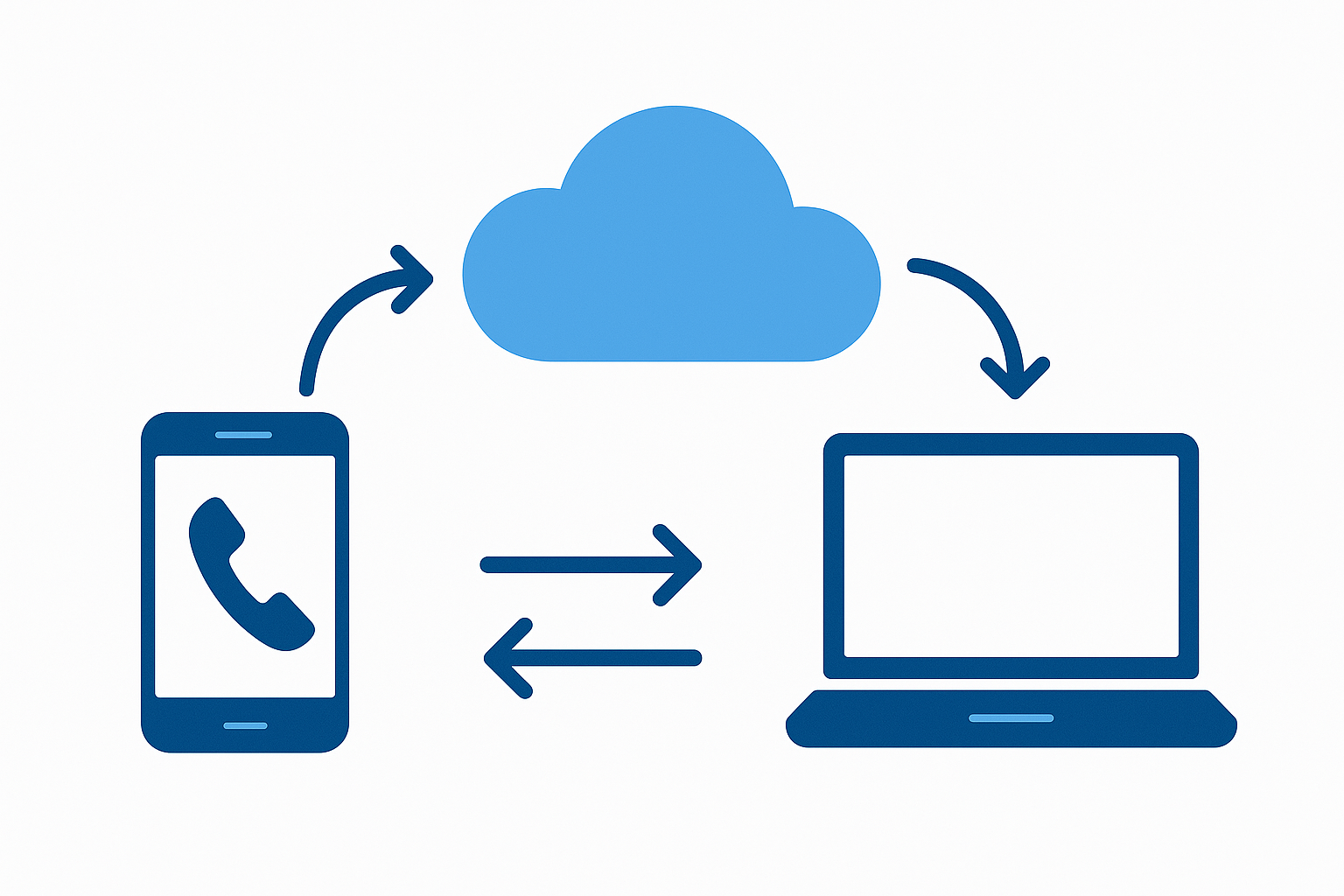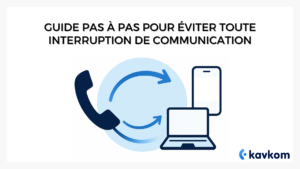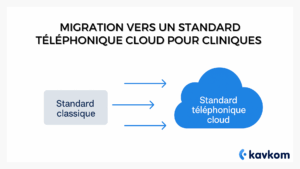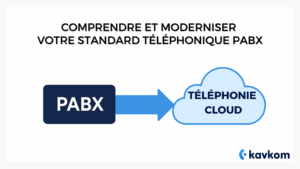Your traditional telephone system is holding you back: high costs, complex maintenance and limited integration with your CRM tools. You suffer from recurring breakdowns, lack flexibility and lose efficiency. Cloud telephony is the ideal solution for modernizing your infrastructure and securing your communications.
In this 5-step guide, you’ll discover how to switch from a traditional phone system to cloud telephony. We’ll show you how to effectively integrate this telephony solution with your CRM tools, while reducing costs and guaranteeing optimum call security. This will enable you to optimize your telephone network and boost your productivity.
Points to remember :
- Cloud telephony replaces traditional standards: no more physical hardware, everything goes over the Internet with a simple interface, accessible from anywhere.
- 5 key steps to a successful transition: diagnosis, solution selection, planning, CRM integration and ongoing supervision.
- Kavkom stands out from the crowd: fast installation, human support, native CRM integration, RGPD security and real-time dashboard.
- Concrete benefits: reduced costs, improved team productivity, better customer relations.
- A strategic tool for modern call centers: flexibility, reliability and centralized management to boost performance.
What is cloud telephony and why modernize your phone system?
Cloud telephony is based on VoIP technology, but goes one step further: it enables calls to be made via the Internet, without the need for fixed lines or an on-site physical telephone infrastructure. Everything is hosted remotely and accessible from an online interface: computer, smartphone or IP phone.
In contrast, a traditional telephone system relies on local equipment (PBXs, cabling, on-site maintenance) that is often inflexible, costly to maintain, and ill-suited to new uses such as teleworking or remote supervision.
For a call center manager, these limits translate into :
- high fixed costs,
- complexity of deployment or updating,
- reduced visibility of calls in progress,
- and the difficulty of adapting the system to peaks in activity or to mobile teams.
The move to the cloud provides a direct response to these issues.
Concrete benefits :
- Lower costs: no more equipment to service, less maintenance, and pay-as-you-go billing.
- Flexibility: adding shifts, adjusting schedules or moving a team is just a few clicks away.
- Enhanced security: communications are encrypted, data hosted in the cloud, with RGPD compliance assured.
By modernizing their systems with a cloud solution, call centers gain in agility, performance and visibility, while better meeting their customers’ expectations.
Step 1: Assess your telephony needs and identify the limitations of your traditional system
Before any migration, it’s essential to take stock of your current system. This enables you to identify the technical and organizational limitations of your telephony infrastructure.
Control points to be examined :
- Maintenance and subscription costs
- Frequency of outages
- Standard update and modification times
- Ability to integrate CRM or other business tools
- Ease of use for remote workers
- Call and supervision quality
Traditional systems often require a high initial investment in hardware (PBX, fixed lines), plus regular maintenance costs.
In comparison, cloud solutions are quick to install, require no on-site hardware and operate on a subscription basis. Maintenance is provided by the supplier and included in the package.
This diagnostic stage is crucial for identifying optimization levers and guiding the choice of an appropriate solution.
Step 2: Choosing the right cloud telephony solution for your business
Once you’ve defined your needs, it’s time to compare the available solutions. To make the right choice, rely on concrete criteria that correspond to your operational challenges.
Criteria to be assessed :
- CRM compatibility: for smooth, centralized customer follow-up
- Easy installation: time-saving, no hardware required
- Quality support: responsive, human and French-speaking assistance
- Security & RGPD compliance
- Call stability & service reliability
Kavkom stands out for its ease of installation (no hardware required), dedicated human support, no-obligation pricing, and optimized CRM integration.
A solution for call center and sales managers.
| Solution | CRM integration | Security | Feedback |
|---|---|---|---|
| Kavkom | Native VoIP + CRM | RGPD, secure data | Personalization and human support |
| 3CX | Dynamics, Salesforce | Standard encryption | Simple interface, wide range of functions |
| Avaya | Popular tools | End-to-end encryption | Omnichannel but dated interface |
Kavkom is a safe bet for simple, fast and efficient migration.
Step 3: Planning and implementing cloud migration
Successful migration to cloud telephony requires careful planning and step-by-step execution.
Key transition stages :
- Prepare the migration: draw up a timetable, inform teams, appoint a project manager.
- Check the technical environment: Internet bandwidth, network compatibility.
- Run pilot tests: on a small group of users to validate the configuration.
- Deploy gradually: team by team, site by site, to avoid interruptions.
- Train users: with short sessions, tutorials or internal referents.
According to Market US, by the end of 2025, 60% of contact centers are expected to have migrated to cloud solutions (CCaaS), in search of flexibility and real-time data.
Tip: choose a service provider like Kavkom who can support you every step of the way with personalized advice.
Step 4: Optimize integration with your business tools and CRM
A good cloud telephony platform doesn’t just handle calls. It must integrate with your software environment.
Keys to successful integration :
- Check compatibility with your CRM tools (HubSpot, Zoho, Salesforce…)
- Activate click-to-call and automatic customer file feedback
- Synchronize calls and recordings in the CRM file
- Automate post-call reminders and tasks
A solution like Kavkom, with native CRM integration, facilitates these optimizations from day one.
Step 5: Ensure the safety, reliability and performance of your new system
Once the solution is in place, you need to ensure that it remains efficient, secure and well managed.
Points to watch:
- Call encryption: to prevent eavesdropping or data leaks
- Secure hosting (EU): to comply with RGPD regulations
- Automatic backups: to protect your call history
- Live supervision: view flows and actions in real time
Measuring performance :
- Track indicators: pick-up rate, call duration, satisfaction rate
- Use the platform’s built-in reports to adjust your schedules, scripts or teams
Tip: opt for a tool with integrated monitoring, like Kavkom, to control everything from a single, live dashboard.
What are the advantages of cloud telephony for businesses?
Modernizing your phone system with a cloud solution is more than just a technological change. It’s a direct lever for performance, customer satisfaction and profitability.
Measurable benefits :
- Lower costs: no more equipment to maintain, pay-as-you-go billing and maintenance handled by the supplier.
- Operational flexibility: teams can manage calls remotely, adjust their activity in real time, and adapt quickly to peak workloads.
- Smooth CRM integration: data is automatically synchronized, customer records are updated during the call, and historical data is centralized.
According to Sia Partners:
- Cloud-equipped call centers have seen agent productivity increase by 18%, thanks to task automation and CRM integration.
- Customer satisfaction rose by 5 points, driven by better first contact resolution.
- Sales increased by 5% thanks to better lead processing and a higher conversion rate.
By choosing a cloud solution like Kavkom, you put a modern, fast-to-deploy tool in the hands of your teams, focused on business needs.
FAQ – Frequently asked questions
Why is fixed-line telephony not optimal for business telephony?
Fixed-line telephony relies on a rigid infrastructure, which is costly to maintain and ill-suited to modern needs such as telecommuting or remote supervision. It lacks flexibility.
What are the most important features of a cloud telephony solution?
Key features include VoIP (internet calling), CRM integration, real-time supervision panel, call recording, intelligent transfer, queue management and activity statistics. All without hardware and accessible from anywhere.
How does switching to enterprise cloud telephony improve communications?
A cloud telephony system streamlines exchanges: faster calls, live supervision, centralized information, better team coordination, even remotely. The result: less wasted time, better quality of service, and greater customer satisfaction.
Conclusion
Cloud telephony is no longer an option, but a strategic choice for businesses that want to gain in agility, performance and cost control. By eliminating the technical constraints of traditional standards, it frees up teams and simplifies communications management.
Whether it’s integrating a CRM, managing calls in real time or offering a smoother customer experience, the benefits are tangible and quickly measurable. Gains in productivity, satisfaction and sales bear witness to this.
Solutions like Kavkom make this transition quick and easy. With no hardware, no commitment, human support and advanced features, Kavkom is a reliable partner for modernizing your telephony infrastructure with complete peace of mind.





